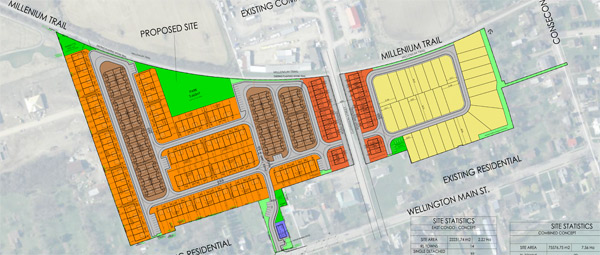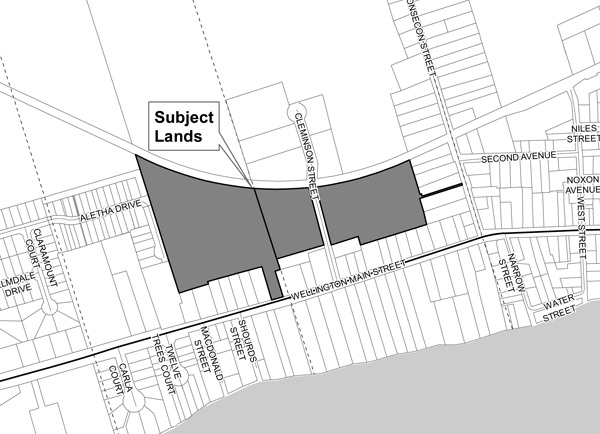Latest Wellington sub-division expansion re-zoning plans approved
Administrator | Mar 21, 2024 | Comments 0
By Sharon Harrison
With plans long in the works for the village of Wellington to grow and expand on a large scale in the coming years, 263 new residential homes took a significant step forward with re-zoning approval.
At the planning and development committee meeting Wednesday, which stretched to a couple of hours on this one agenda item, council gave the go-ahead for the re-zoning of land by approving a zoning bylaw amendment which would allow single detached and townhouse dwellings to be developed on the property.
Owned by Sterling Homes, the site (which is actually two separate sites divided by Cleminson Street) consists of property located at 380 Main Street and 0 Cleminson Street in Wellington. The site does not currently have water and sewage infrastructure in place.
“This is a development Wellington really does need” said Corey Engelsdorfer, Wellington ward councillor. “This is certainly much different to anything Wellington has seen before, and I’m not sure that’s a bad thing,” said Engelsdorfer. “For a community to grow in a healthy way, we need a more diverse range of housing than we currently offer.”
It was a full gallery as much discussion ensued by council, and members of the public, specifically residents of Aletha Drive directly impacted by the proposed townhouses abutting the western edge of the property, and it proved to be the main sticking point of the meeting.
It was noted by Sterling’s representative, Jim Levac of Glen Schnarr and Associates, that Aletha Drive is a private road that runs parallel to the Sterling property line that Sterling don’t have access to.
“If this had been a public road, we would probably have re-oriented this a little bit differently, because we would have potentially fronted units onto that to take advantage of the road that was already there,” Levac said.
Michael Michaud, manager of planning for the County said “if this was a normal situation, there would be fronting units, not backing units, and basically we’ve been told to go fly a kite [by the owner of the road]. It would be nice to have fronting units to have a cohesive road, provide lower density at this location, so a mix of singles and towns.”
Michaud confirmed Aletha Drive is owned by an entity by one developer.
Comments from 10 members of the public largely objected to the proposal in its current form, where density, a reduction of lot sizes and reduction of landscaped open space were noted as concerns, along with over-development, protection for the creek, mature trees and wildlife running through the site. Also raised by some residents was a lack of transparency and communication by the developer and the municipality with residents, especially those most severely impacted.
Several residents concluded the positioning of the townhomes on the western edge of the site impacting those Aletha Drive residents was as a result of the developer using outdated planning maps which do not show that the bungalows exist on Aletha Drive.
Chair of the Wellington Community Association, Joanna Green, said, in principle, the group supports the development, “with some very serious caveats”.
“We trust the Sterling Homes development will be appropriate in its size and scale and will include a significant number of affordable and attainable housing units, with density conforming to the Wellington secondary plan (25-37 units per hectare),” said Green.
She said they also expect the development will be designed and built with environmental sustainability in mind.
“Most importantly, we expect that the project will be in keeping with existing character of Wellington and will reflect our village’s values and priorities.”
Danielle Lindholm, who lives on Aletha Drive, objected to the re-zoning application, where she expressed great concern for over-development and asked for a less intrusive concept plan.
“The revised concept plan for 250 (previously 240) dwellings is excessive and not in keeping with neighbourhood aesthetics,“stated Lindholm. “The proposed two- and three storey townhouses will look like a brick wall, with no natural barrier between this proposed development and the existing homes on Aletha Drive.”
She went on to say that “growth is good, as is affordable housing, but over-development is not good due to negative impact, such as intensive urban growth can lead to greater poverty, overcrowding, traffic congestion, urban crime.”
Dorothy Bothwell expressed concern about how each of the three revisions made by the applicant further reduces the lot sizes and setbacks, saying “what this does it puts more home and less green space on each lot”.
She asked why 39 units per hectare is OK for the west parcel, and only 22 units per hectare for the east parcel when there are a similar number of Main Street estate lots backing onto it, as well as a number of one-storey bungalows (she compared the nearby and recent Twelve Trees development as being 25 units per hectare with tiny front and back yards).
“The Sterling development will significantly change the character and fabric of our historic small village of 1,900 residents,” added Bothwell.
One couple who reside on Aletha Drive where the townhouses are proposed on the western property line both spoke to the impact of having towering structures situated so close to their little bungalow, and that of their neighbours.
“Thirty-one two-storey town home units are to be built right along the property line with their immense back wall facing us. These units are to have small back yards with concrete slabs for barbecue patios for people to enjoy their recreation,” she said, “That’s most likely 100 people enjoying their barbecues in front of us, with no privacy.”
Another Aletha Drive resident (who directly faces the proposed townhouse wall) affected by the townhouses on the western edge spoke to “terrible design”, reduced quality of life, density and diminished property values, describing the aesthetic as a “nightmare”.
“Where in the County would you find residents coming out of their front door to be confronted by a complex stretching greater than two football fields, 264 yards?” he asked. “This is a complex one would find in a major metropolis, not in of all places in the middle of a village, not at a highway exit ramp on the outskirts of a major city, and a mere few feet away from this established retirement community.”
“The proposed structures on the west end equals three Wellington arenas end-to end- to-end and we are to be practically attached to it. For us, it would be living in an inner city with a back alley facing us.”
Representing Sterling Homes, Jim Levac with Glen Schnarr and Associates gave a brief presentation, and was joined by Paul Mondell , project manager with Sterling Homes.
Levac described the lands as being located centrally within Wellington centre, designated “urban centre” and the secondary plan permits a range of ground-related residential uses, including detached dwellings, townhouses and low-rise apartments in the range of two to four storeys, he said.
The density range for this designation is 14.5 to 37 units per net residential hectare.
Councillor Chris Braney spoke to how council has been wanting to see some density and affordability when it comes to new development, where he noted how many residents want their children and grandchildren to stay within the County if there is an opportunity.
He also spoke to the important component of schools, one he described as “very crucial” and one people need to be very aware of, he said.
“We have a local school, and local schools in rural communities’ are at great risk right now of accommodation review, the province pulling the plug from underneath us without us having any control or power over that,” Braney explained. “I see this opportunity of making this village vibrant, we need a vibrant flourishing community and this gives us an option.”
He said this is first plan he’s seen in two years where there are concepts of affordability, some density and some opportunities for County residents and their children and grandchildren to maybe have a life here and stay within the County.
“More importantly to me, the schools are the social safety net of our communities rurally these days; if we lose our schools, we lose our heartbeat of our community.”
Currently vacant, the sites consist of 5.33 hectares (west of Cleminson Street), and 2.22 hectares (east of Cleminson Street), for a total of 7.58 hectares, with the Millennium Trail as its northern boundary, and Main Street as its southerly boundary.
The zoning bylaw amendment application to Special Urban Residential Type 3 zone allows a multi-residential development on private infrastructure consisting of 263 units in total.
Matt Coffey, planning co-ordinator, approvals with the County notes in his report that a public information meeting was held in November 2023 with comments and concerns expressed by members of the public in attendance have been addressed, but were “generally positive”.
Several written comments from those residents living in close proximity of the proposed development were also received as part of the application documents.
The report notes those existing properties adjacent (west and south) of the proposed sub-division consist of existing low-density, single detached dwellings.
Bounded by the Millennium Trail to the north, there are also lands associated with the Wellington Home Hardware Building Centre located north of and adjacent to the trail. The vacant lands north of the site are designated as neighbourhood development area.
The development west of Cleminson Street will consist of approximately 207 residential units, to include a mix of townhouse styles, such as back-to-back townhomes, rear lane townhomes, and front lane townhomes.
Parkland dedication of 4,848 square meters (equivalent to 6.3 per cent) is provided in the western portion of the development and will be accessed directly from the private road network and from the Millennium Trail.
Two new private streets would provide access to this portion of the development. The access points will be from both Cleminson Street and Main Street.
The development east of Cleminson Street would consist of approximately 46 units comprised of 32 single detached homes, and 14 rear lane townhomes.
“Also, along the entry feature, off Wellington entrance, there is a mixed use building, although we are not entirely sure what we are going to put there, and we have asked for permissions to use as a temporary sales office initially, but with the potential that it could be converted into a retail use with a couple of apartments on top,” Levac said.
A large park and open space along the Millennium Trail have been incorporated into the design. This portion of the development is to be accessed via a private street connecting to Cleminson Street with the entrance adjacent to the west side entrance.
“Both the east and west portions of the development will consist of parcels of tied lands on a common element road plan of condominium,” noted Coffey.
Special provisions proposed are aimed at implementing the type of housing products being proposed and include specific yard requirements such as lot frontage, side yard setbacks and landscape requirements.
Councillor Roy Pennell expressed concern about the townhouses only having 19-foot rear lanes, saying there is no room for families, and describing it as “absolutely asinine”.
“The 19-foot rear lane townhouse is almost to the point of a ghetto situation because of families being there, and I look at the front yards and there is nothing,” said Pennell, who asked why it was so narrow.
Levac noted that the OP encourages a mix of build forms, “and we are proposing to provide that mix, the whole idea is to provide a range of income groups, whether it’s someone who wants to downsize, an empty nester or a first-time buyer”.
Mondell reminded that with rear lane townhouses there is no garage in the front.
“Instead of having what you would typically see as a one-car garage, which would be maybe 10-feet wide, you are going to have the full width of that unit for living space, and the garages in behind, so that 19-feet is fairly generous for a rear lane townhouse.”
Levac said it wasn’t out of character with what is being built elsewhere, “as housing is getting smaller and it’s getting compact, affordability has become a big issue, and this particular developer wants to provide a range of housing types that could appeal to people who may not otherwise be able to buy in Prince Edward County”.
Councillor Phil St-Jean asked about target price points where Levac said it was too early, with a number of hurdles to overcome yet, before marketing could begin, something he estimated could start in 12-18 months. Dodging the question on commitment of price points and affordability, Levac said, “It’s a very difficult conversation; what does affordability mean? I like to use the word ‘attainable’”.
He noted that the nature of this condominium housing, from the municipality’s perspective, there is nothing the municipality would have to pay for once the site is developed because it will be private development and condominium-based, as all roads and facilities would be private and managed by the condominium corporation (with the exception of Cleminson Street which is owned and managed by the county) – and would be run similar to that of Wellington on the Lake, he said.
“Condominiums tend to be a little bit cheaper, but there is condo fees typically involved, so you have to marry that balance with what monthly fees are to maintain all this infrastructure versus what the municipality isn’t paying for road maintenance and so on,” he said. “This is going to be inherently more affordable before we even talk about square feet.”
Councillor Brad Nieman also asked about timelines for the project, where Levac reminded about the big issue of infrastructure and water capacity and sewer capacity.
“We believe that we have easy access to sewer and water hook-ups here that could get us started earlier, but as of today we still have some decisions to make,” stated Levac. “As of today, we have no water and sewer capacity here.”
He indicated that marketing could begin next year, and “and within this time next year, shovels in the ground”.
Parking requirements are also specific to the unit type ranging from one space per unit (for back to back townhomes) to four spaces per unit (for detached dwellings). Coffey’s report states that the allocation of visiting parking provided will be 0.2 spaces per unit.
The Wellington secondary plan recognizes the preferred intensification target for residential density to be 25 units per net hectare, with a maximum of 37 units per net hectare. The applicant is proposing a density of 33 units per net hectare across both the east and west portions of the site.
A small commercial component accessory to an apartment is also proposed. The location of the commercial component would be located near the Main Street entrance. Uses permitted would be limited to locally-orientated services such as a bank, medical clinic or convenience store.
Coffey’s report noted that municipal sewage services and municipal water services are the preferred form of servicing for settlement areas.
The report noted that water and sanitary allocation to the site is conditional due to the existing limited capacity within the village.
“The availability of services has been noted as a condition of approval and is a requirement for the removal the “hold” provision that is included in the proposed bylaw. Servicing availability will also be required prior to the execution of a site plan control agreement.”
“The development will consist of a private water and sanitary service designed within the network of private streets. This water and sanitary system will connect to municipal services, but will be the sole responsibility of the future condominium corporation to construct and to maintain.”
In their report to the planning department, Quinte Conservation noted that according to the EIS (environmental impact study) there is a small wetland and intermittent watercourse on the site. A permit will be required for development within 30 meters of these features.
Several councillors reminded that extended discussion on the topic, beyond the norm, was due to the new provincial rule change that means this item will not come back to council again for discussion, with site plan approval being delegated by staff under the new rules.
Council’s decision is to be ratified at the next council meeting March 26.
All planning documents relating to the proposed Sterling Homes sub-division application can be found on the County’s website
Filed Under: Featured Articles • Local News
About the Author:



































